Nearly three-fourths of all Laysan albatross nest at Midway Atoll. Kim Rogers went to Midway to count them. The experience — and the birds — stuck with her.
A bump of land in the Pacific Ocean, midway between North America and Asia, so faint on the horizon it could be mistaken for a mirage by starving shipwrecked sailors. Situated at the northwestern tip of the Hawaiian Island chain but so remote that if Hawaiians once inhabited or utilized any of the three coral rubble islands dotting the southern swing of the atoll, no evidence remains, no place name survived its way through time. So remote it wasn’t mapped by a Westerner until 1859, and still you may not find these specks of land on a globe without a magnifying glass. So remote that if there were a bridge long enough, it would take fifty-two-and-a-half hours of driving at 60 miles per hour to reach the atoll from Seattle. So remote the birds outnumber human inhabitants by tens of thousands to one.
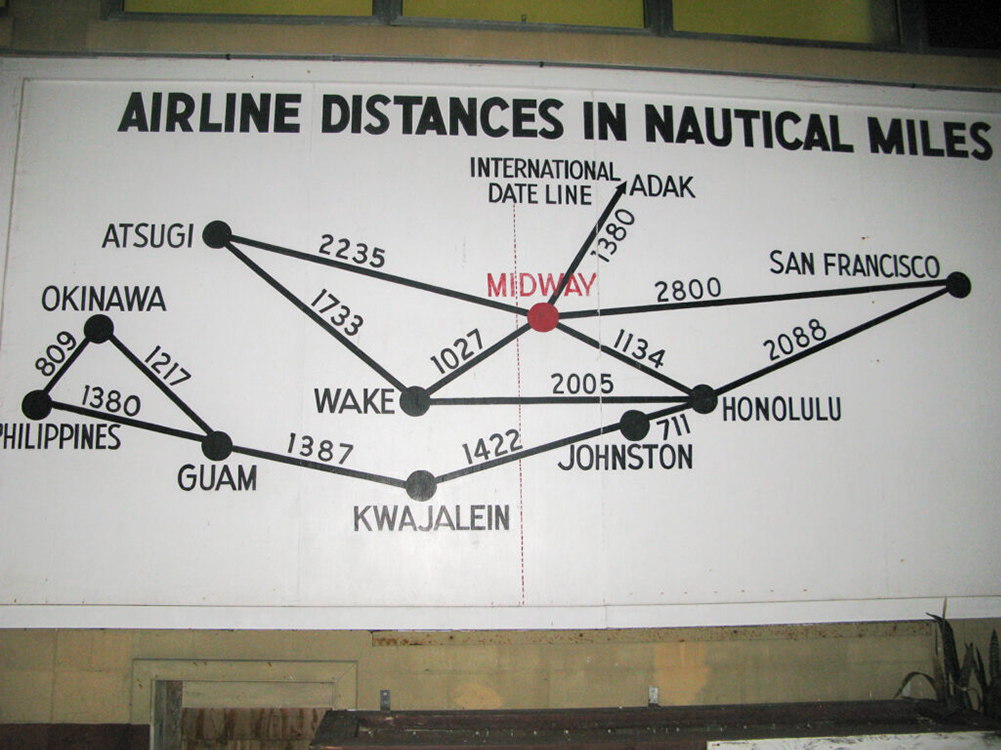
I wasn’t a birder then; I don’t really consider myself one now. I went to Midway to help count albatross nest sites, because the whole thing sounded like a great adventure. Because it gained me entry to a remote collection of coral islands.
And yet Midway is a mountain — or what’s left of one — that first popped above the surface of the sea some 1,615 miles away and 28 million years ago thanks to a hotspot releasing molten lava at the earth’s crust and now actively forming the large island landmass known as Hawaii Island. All the Hawaiian Islands once sat over this very hotspot but every year move a few inches to the north-northwest due to the shifting tectonic plates that make up the outermost shell of the Earth’s crust. Over millennia, Midway has not only moved, but wind and water has worked to erode its surface while its weight has caused its subsidence. Essentially, it’s shrunk and sunk. The original island—or mountaintop—now sits below the surface of the sea. What remains is a nearly complete circle of reef that surrounded the island and inside that, a lagoon.
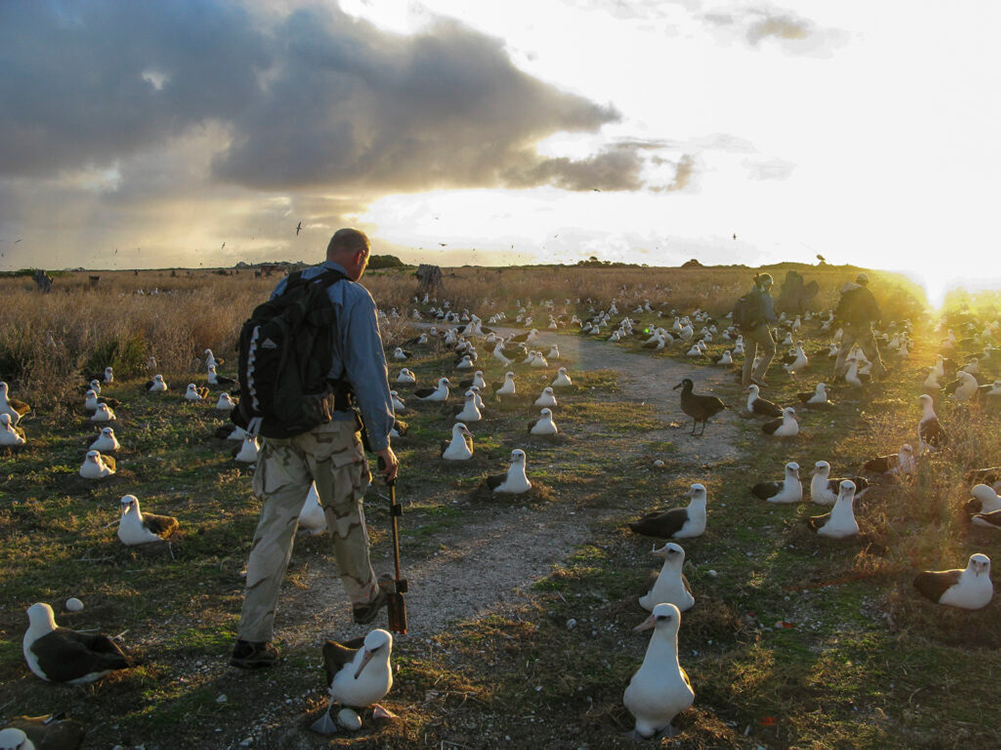
I went to Midway once.
My plane touched down during the dark hours of early morning, nearly five hours after departing Honolulu International Airport. Apparitions of white lined the runway like a military parade, cheering my arrival. These, I would realize, were albatross.
I wasn’t a birder then; I don’t really consider myself one now. I went to Midway to help count albatross nest sites, because the whole thing sounded like a great adventure. Because it gained me entry to a remote collection of coral islands.
I hadn’t spent time in the immediate company of albatross before, so I didn’t know their sounds. Didn’t know their smells. I most definitely didn’t comprehend the density of a million-and-a-half albatross on a patch of land one-third the size of Honolulu International Airport. Nearly three-fourths of the world’s population of Laysan albatross nest at Midway, their nests crowding the ground. The lot of them reminded me of my bookshelves, books lined up side by side, books double-parked.
After moving my gear into my room in an ex-Navy barracks, I took a nap. Three hours later, I woke to a rapping at my door. There were 15 of us volunteers enlisted to count albatross nests. Was this a fellow volunteer? When I opened the door, the threshold stood empty. As I stared at empty space, I heard the sound again. Knock. Knock. Knock. It was an albatross clacking its bill outside my window.
Later that day, I selected my vehicle for my stay—a bicycle. Then, I received a paint gun and clicker. Outfitted with the necessities, I headed for the first field of birds. My job was to mark and count nests. I did it by spraying a fluorescent orange dot of water-soluble paint next to a nesting albatross with one hand and pressing a counter with the thumb of my other. By the end of my stay, I estimate I pulled the trigger on my paint gun some 30,000 times, and the blister on my thumb grew, popped, and healed over.
I went to Midway once.
I learned Midway is storied.
There is the story about Captain Brooks who in 1856 claimed the three specks of land at 28 degrees north latitude and 177 degrees west longitude for the United States, not the Kingdom of Hawaii, resulting in an unusual situation in which Midway is the only collective of islands in the Hawaiian Island archipelago that does not belong to the state of Hawaii. There is the story of guano miners, scraping millions of years of bird excrement off the atoll for use as fertilizer. Stories of shipwrecks. Stories of egg collectors rolling giant wooden carts across the islands, gathering albatross eggs, a source for photographic albumen. Stories of the Pacific Mail Steamship Company’s unsuccessful lobbying for the creation of a harbor—by blasting through the atoll’s encircling reef — and coal re-fueling station for their California-to-China run. There were other stories, too, some grisly. Stories of feather collectors bashing albatross dead to supply the millinery trade with feathers. Stories of murderous shipwrecked sailors.
There is the story about the Pacific Commercial Cable Company who set up shop in 1900, connecting Midway, Guam, Waikiki, and San Francisco with cable service. The story of Pan Am Airlines making its first landing at Midway in 1935. They brought a movie projector with them, screening Red Hot Mamma, and using the stop as a refueling station for their seaplanes en route from San Francisco to the Philippines. The ticket price for a seat aboard the fledgling airline’s “Flying Clippers” was purported to be three times the average annual salary of an American. Supposedly, Ernest Hemingway was a passenger, and he stayed at the Reef Hotel built on pilings 30 feet above the outer reef.
Waves, temperature, and light: These are our cues to shifting seasons in Hawaii. I wonder what cues Laysan albatross use. What makes these majestic birds with their six-and-a-half-foot wingspans turn south, away from the rich foraging waters of the North Pacific, and head for land?
Then, there is, perhaps, the most famous story out of Midway — the Battle of Midway — known as the turning point in World War II. There’s obvious evidence of the military’s one-time presence here in the remaining buildings, bunkers, runway, and more. But before that happened, on the day of infamy on December 7, 1941, after bombing Pearl Harbor, another Japanese raiding party attacked Midway, killing four. Six months later, the Japanese returned. The resulting story opened this weekend as a major motion picture.
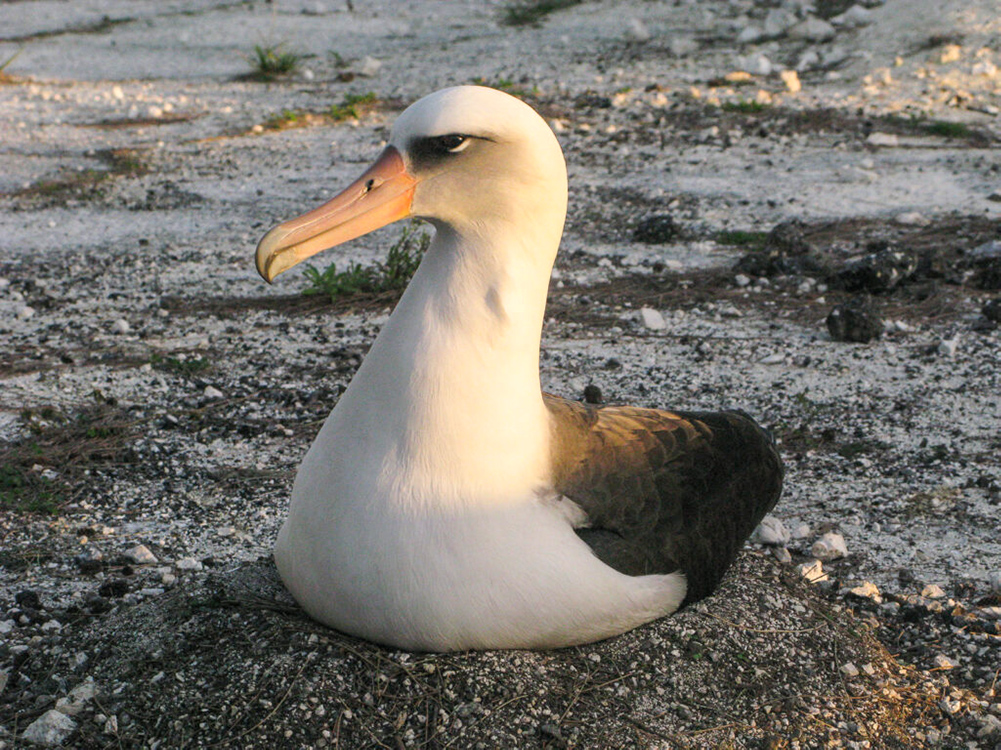
Today, the three coral islands total two-and-a-quarter square miles of land and 85,929 acres of water, and it’s protected as Midway Atoll National Wildlife Refuge. After extensive research into Hawaiian chants, the place was given a Hawaiian name — Pihemanu. That translates to English as “loud din of birds.”
I went to Midway once.
On my fifth day, the weather turned abysmal. Highs in the 50s with 40 mile-per-hour gusts. And still we counted albatross nests. The ornithologist leading our efforts said, “This is perfect albatross weather.” Albatross love big wind. The windier, the better. Typically, these soaring birds spend most of their time foraging for food in roaring seas between latitudes 30 degrees and 55 degrees. Carl Safina, author of Eye of the Albatross, says albatross don’t fly, so much as they float.
A team of “Coasties” arrived the day before. Their Coast Guard plane limped into Midway with one engine down due to the loss of some hydraulic fuel in a propeller. Stuck waiting for another plane to arrive with a part, the pilot helped count nests. He said the prop’s malfunction wouldn’t allow the propeller to adjust its pitch. I suggested he take flying lessons from albatross. They can fly hundreds of miles without a single flap of their wings — simply by adjusting the pitch of their wings.
It’s hard not to anthropomorphize with these birds. Especially when you approach the calm ones, and they lift their heads to look at you, then angle it to get a better view. When you look into their eyes, they look back, and you can tell there’s somebody home. It makes you wonder what they’re thinking. If they remember some really big creature coming by the year before and leaving a paint splotch by their nest. You wonder things like. How does it know where to go to find food? How does it know its mate, the one they partner with year after year? You wonder how old the particular albatross might be and how many chicks it’s raised.
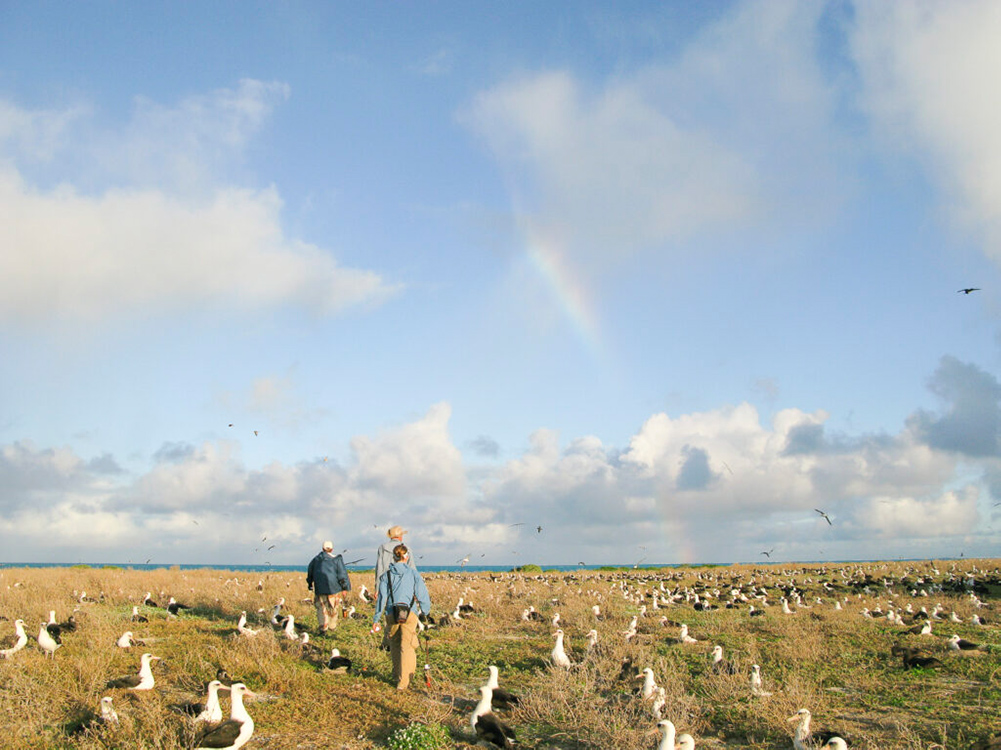
One of the organizers of our albatross count lived on Midway with her military family in the late 1950s. She was 10 and remembers “pet” albatrosses nesting next to her family house. Many of the Navy’s buildings have been bulldozed over the years as the Cold War ended and the population receded from 5000 to 50, but Jenny’s childhood home still stands and an albatross still nests outside it. Because albatross have strong nest site fidelity—they nest in nearly the exact same spot year after year—I can’t help but wonder whether the albatrosses nesting outside her family home are the same pair that Jenny befriended as a 10-year-old. The oldest known wild bird in the world is a Laysan albatross, and she was banded in 1956.
I went to Midway once.
Now, whenever November rolls around, I stare at the sea, scanning for Laysan albatross skimming the surface, hoping one will appear out of the ocean mist rising from a freight train of waves crashing on shore.
Early November. Elsewhere in the world, leaves are turning yellow, red, and orange, carpeting the ground in color. In Hawaii, where I live, the first winter swell rolls in. Daytime temperatures still topple 80 degrees but are finally dipping into the mid-70s at night. This is a great relief after a summer of record-setting heat washed over the islands where most of us live without air conditioning. The setting sun is no longer visible from Hanalei Bay on Kauai’s north shore but has tucked behind the stunning series of monoliths that make up of Na Pali Coast, as we tilt away from the great star around which Earth orbits.
Waves, temperature, and light: These are our cues to shifting seasons in Hawaii. I wonder what cues Laysan albatross use. What makes these majestic birds with their six-and-a-half-foot wingspans turn south, away from the rich foraging waters of the North Pacific, and head for land? Do they look up from a pile of squid one day, tilting their beautifully airbrushed faces to the sun and think, “Hmm, the angle of the light is different?” Even with their layered coat of warm, fluffy feathers, do they feel a drop in temperature? Do they smell a specific wind, something like a Santa Ana? Maybe it’s hormones, a likely culprit. Does a sudden release of hormones drive these imperiled seabirds to make a U-turn? Because the only reason they drop their spatula-sized feet on hard land is to breed. In the last several decades, more are flying further south and re-colonizing the main Hawaiian Islands.
“So, they’re on their way right now?” Kelvin asks. We’re surveying an area where albatross like to nest on Kauai. He’s wearing a shaggy beard and a trucker’s cap low on his forehead, but I can still see his eyes, and I recognize the look on his face. The amazing facts about albatross are clicking into place for him in the way orderly way bricks are laid. The way they did for me 12 years ago.
Albatross are nothing like the way they’re often portrayed. They’re not burdens. They aren’t bad luck. I’d just explained to Kelvin how when a Laysan albatross decides to depart the chilly waters near the Aleutian Islands, some two thousand miles north of the Hawaiian Islands, that it may take two weeks traveling at speeds up to 40 mph to arrive back at their nesting grounds on Kauai. How albatross can soar up and over ocean waves the way a prima ballerina performs a grande jeté—seemingly effortlessly. How they can “sleep on the wing,” the way a dolphin goes into rest mode, shutting off half its brain while the other remembers to breath and navigate. How albatross can fly for hundreds, if not thousands of miles, on a single flap of their wings. Carl Safina writes, “An albatross is the grandest living flying machine on earth.” No wonder.
The earliest day I’ve witnessed the return of Laysan albatross was November 4th. The latest was November 11th. Last year, was a happy middle of November 8th. Laysan albatross are considered synchronous nesters. That’s because they do not spend their adult lives in flocks. They are solitary, criss-crossing the North Pacific, ticking off tens of thousands of flight miles a year, hooking up with their mates each November to breed and raise the single chick they produce together. Albatross are fiercely loyal to their mates, forming long-term pair bonds that can last decades, but if they mis-time their hook up, there won’t be a chick, and they’ll have to wait another year to try again. Will the male with the leg band of H614 be the first one back again this year? Will KP66 and KP211 nest under the same ironwood tree they’ve selected for the past 10 years? These are the questions I start asking myself every year as summer swings into fall.
As always, I’m eager for their arrival, but this year, a little fearful, too. The headlines of mass marine die-offs slide into my email inbox every week. This year, Pacific gray whales are stranding and dying at a rate four-times greater than typical. Arctic ice seals in Alaska are dying at five times their normal rate. Birds are being hit hard, too. More than 8,000 common murres were found dead earlier this year on a beach near Whittier, Alaska, southeast of Anchorage. Near the other pole, in the Antarctic, only two chicks out of a colony of nearly 40,000 survived. Starvation seems to echo throughout all these deaths. It makes me wonder if we’ll start seeing fewer and fewer returning albatross.
It’s quiet now as Kelvin and I check for hazards like fallen limbs that can trap birds. We clear weeds from under trees where albatross pairs have nested in the past. But soon, I hope, the soundscape of the place will be filled with the clacks, moos, whinnies, and whistles of Laysan albatross pairs, reconnecting with their mates after months of life apart at sea. I may spend more time preparing for the albatross’ annual return than I do a rare visit from my Midwestern parents. My poor mother. Whenever she said, “I miss you. I wish you were here,” I heard, “Why did you have to move so far away from home to find your home?”
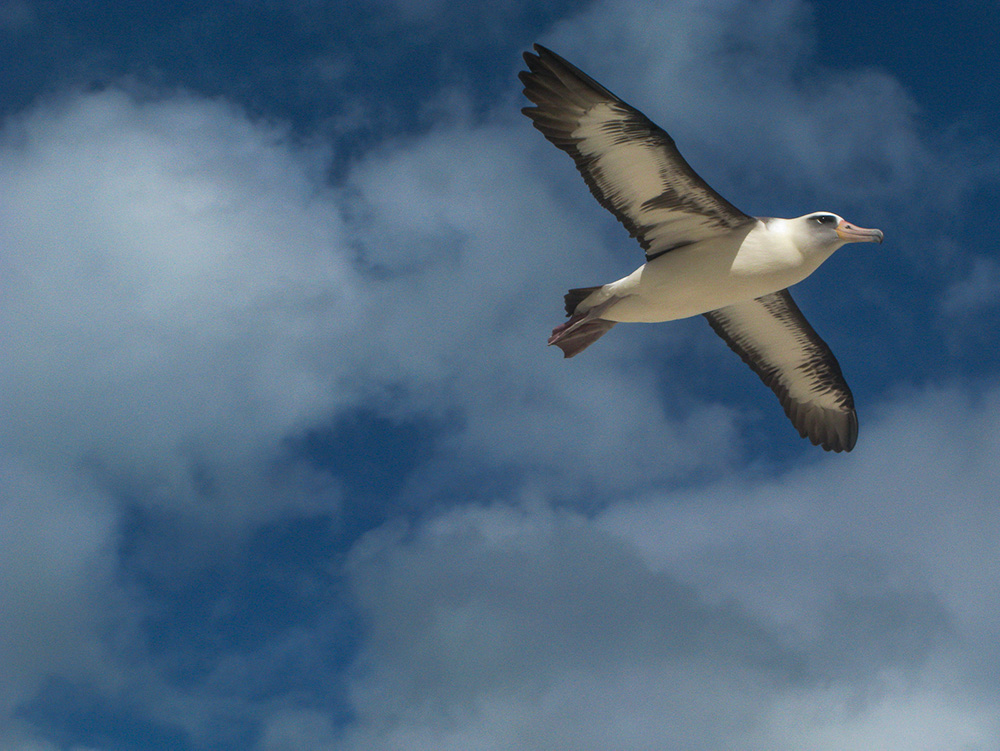
Four days later, Kelvin texted me. “A bird showed up.”
It was H614, the same bird who arrived first last year, on the same day, in the same exact spot.
I went to Midway once.
Twelve years later, I realize the answer to my mother’s unvoiced question: Albatross.
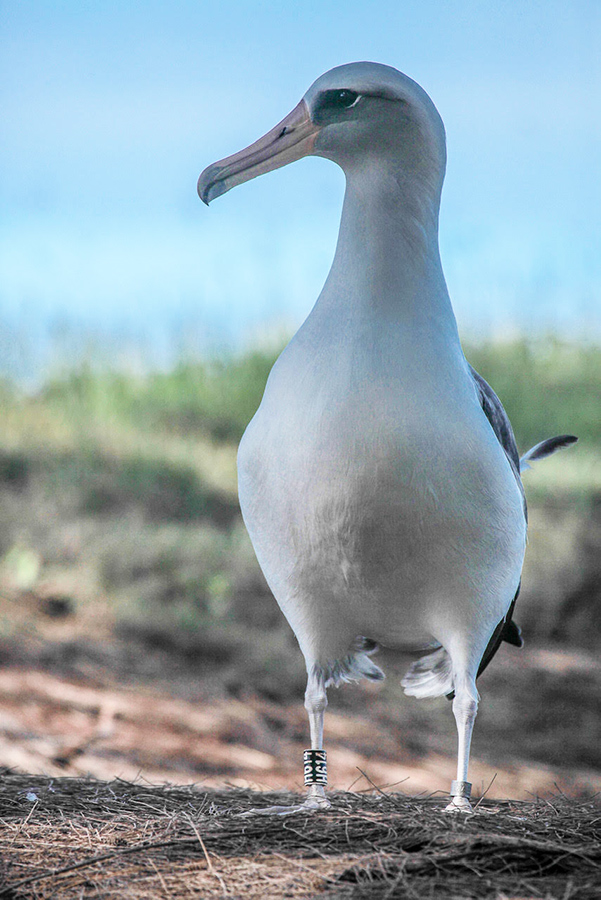
All photos copyright Kim Steutermann Rogers. Find more photos from Kim and learn about the Laysan albatross at www.albatographer.com. 20 percent of purchase go to support organizations dedicated to helping albatross.
